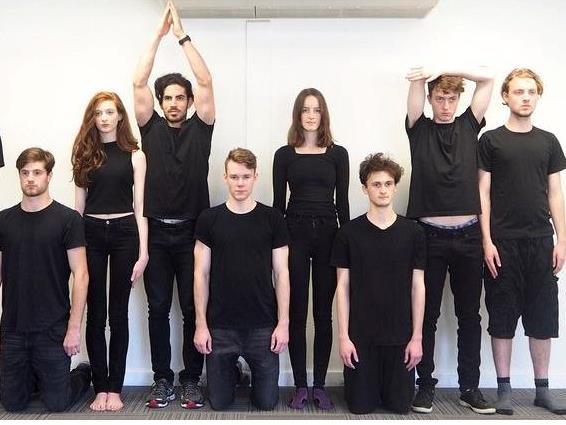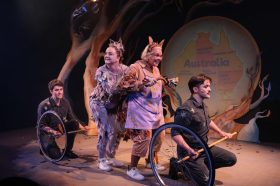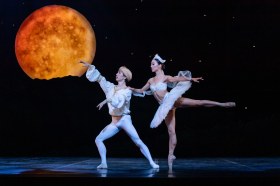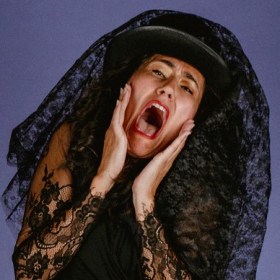The Brick and The Rose presented by the Actors’ Hub. Image via Actor’s Hub Perth.
The Brick and The Rose is the story of Tommy De Santo, as well as the tale of the changes in New York City from 1950s onwards. Threaded together on a lyrical narrative string, moments of Tommy’s life from his birth, his father’s death, school, wandering around town on his own and then as part of a gang, falling in love and seeking after life’s deeper meaning are all created through fragments of dialogue, flashes of movement and a montage of sound effects created by the performers.
Director Adam Mitchell worked with a group of young actors to present this work and was originally designed as a play for voices for radio. Mitchell’s sparse set design, a row of stools with black clad actors in front of black curtains, leaves nowhere for the performers to hide. Each actor must step forward and speak, sing and move to create a life story using only their own dramatic force. Mitchell has not spared his performers the difficulties of presenting so many different characters without a single prop on the stage, and yet the diverse cast of Tommy’s life comes through.
Nicholas Allen as The Voice handles the dense text of the narration strongly, his fluid vocals taking on the many similes, metaphors and runs of long words without breaking stride. He skilfully introduces characters without interrupting rhythms elsewhere, allowing abrupt changes to make sense. Lauren Thomas plays several characters, Tommy’s mother, Mrs Donahue and a prostitute among them, each with clear and consistent appropriate accents. Thomas fixes us with her stance, challenging the world in the face of her characters’ despair and difficulties, as well as producing some giggles, chuckles and sobs that cause the skin to crawl. Kira-Che Heelan plays Tommy’s sweetheart, Alice, and brings a real sweetness to her various parts of a whimsical young lover and a child at play, with good levels of energy. Benjamin Costantin pushes his accent work when switching between Tommy’s friend Al and Mr Donahue. Costantin’s strong eye contact holds audience attention with each part. Christian Tomaszewski makes the most of his opportunities for physical performance, his clear, controlled movements livening scenes otherwise cluttered with wordplay.
Zach Clifford does not entirely capture the old-eyed, old-souled seeker after truth as Tommy, but interacts well with all the supporting parts in the oddly detached dynamic required by the elongated stage set up. Andrew Dunstan captures the superficial virtue and friendliness of the neighbourhood drug dealer who sends Christmas cards each year, with particularly good facial expressions conveying Freddy’s way of seeing the world. Adam Droppert contrasts his facility with spoken lines with a gang member’s devastating violent streak when taking revenge for an insult for his ‘gimp foot’ after a local dance; singing nursery rhymes while stomping on a head, in another dramatic outburst to break the flow of words marking this work. Quintus Olsthoorn is reliable in all his smaller parts, bringing other points of view to each crowded scene.
Jarrad Jenkins’ lighting design and recorded sound moments are kept basic but tight, focus switching between the many players quickly and appropriately. The main soundtrack is provided by the non-performing actors on their stools, stomping feet, slapping hands, humming, moaning, beatboxing their way through a sound medley of New York City’s crowded streets through time.
Mitchell foregrounds the richness of Lewis John Carlino’s words, the actors bringing these to the stage to starkly present the struggles of life in the defined time and place of the crowded streets of Hell’s Kitchen. The Actors’ Hub has accepted the challenges of the themes of love, despair and addiction that run through The Brick and The Rose, bringing out some strong performances from the young cast members. Future work from the company as well as the individual performers will be awaited with anticipation.
Rating: 3 1/2 stars out of 5
The Brick and The Rose
Written by Lewis John Carlino
Presented by The Actors’ Hub
Directed by Adam Mitchell
Sound and Lighting Operation: Alice Carroll
Lighting Design: Jarrad Jenkins
Set Design: Adam Mitchell
Subiaco Arts Centre, Subiaco
24 – 26 November 2016





